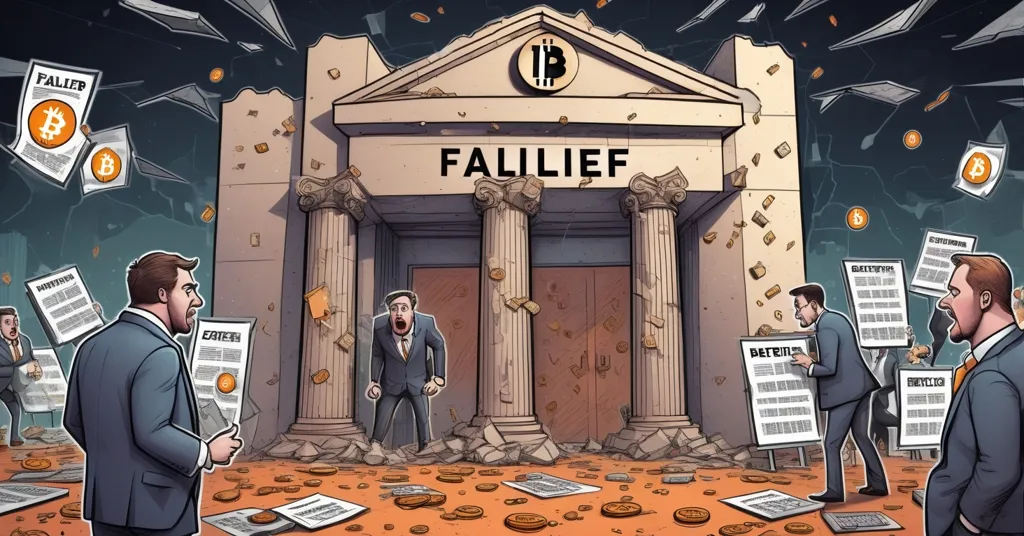FTX Creditors to Get $1.9B by 2025: Relief or Rip-Off with Outdated Valuations?

FTX Creditors to Receive $1.9 Billion by September 30, 2025: Relief or Raw Deal?
Picture losing everything in a single, catastrophic collapse—FTX creditors have lived this nightmare since November 2022. Now, a Delaware bankruptcy court has greenlit a $1.9 billion payout, with distributions slated to begin by September 30, 2025. It’s a lifeline for many, but dig deeper, and you’ll find a minefield of frustration, outdated valuations, and looming market risks that could rattle the crypto space.
- Massive Payout: $1.9 billion to be released, record date set for August 15, 2025.
- Verification Barriers: Strict KYC and tax checks leave unverified users empty-handed.
- Valuation Gripes: Payouts pegged to November 2022 prices, ignoring epic market gains.
The Long Road to Recovery
FTX’s implosion in November 2022 wasn’t just a financial flop; it was a betrayal that shattered trust across the crypto landscape. Billions in customer funds evaporated under allegations of fraud and gross mismanagement by former CEO Sam Bankman-Fried, now serving a 25-year sentence. Since then, the Delaware bankruptcy proceedings have dragged on, tasking the FTX Recovery Trust with scraping together assets to make creditors whole. This $1.9 billion release, made possible by slashing disputed claims reserves from $6.5 billion to $4.3 billion, follows a $2.5 billion payout in 2024. Progress? Sure. But let’s cut the fluff—this is far from a fairy-tale ending. For those seeking deeper insight into the process, the FTX bankruptcy recovery details offer a comprehensive overview.
The payout process itself is a bureaucratic gauntlet. Creditors must jump through hoops of Know Your Customer (KYC) verification—a process akin to showing ID at a bank to prove your identity—and submit tax documentation. Fail to comply, and you’re out of luck, no matter how much you lost. This rigid setup aims to prevent fraud and ensure legal compliance, but it’s a bitter pill for users who trusted a centralized exchange like FTX to handle such red tape in the first place. Worse, if you’re in one of the 49 excluded countries—where a staggering 82% of claims reportedly hail from China, a nation with a blanket crypto ban—don’t hold your breath. FTX isn’t playing global savior here. The lack of transparency on why these regions are sidelined fuels a growing sense of injustice. Is this recovery, or a selective handout?
November 2022 Prices: A Slap in the Face
Here’s the real gut punch: your payout is locked to crypto prices from November 2022, when the market was bleeding out post-FTX collapse. Bitcoin wallowed at around $18,000, Solana scraped by at $15, and most assets were at rock bottom. Fast forward to early March 2025, with Bitcoin sitting at $82,835 and Solana at $136, and you’re looking at gains of nearly 500% for BTC alone—gains you won’t see a dime of. A frustrated user on X summed it up raw and real:
The payouts are based on prices from two years ago. BTC’s up 5x now—this money means nothing!
That rage is palpable, and it’s hard to disagree. If you held Bitcoin on FTX during the crash, you’re getting scraps compared to today’s value. Oddly, Ethereum claims are a rare win, valued at $2,500 back then against $2,066 now, but that’s cold comfort for the majority. Legally, fixing valuations to a specific snapshot like November 2022 makes sense—it avoids endless disputes in a volatile market. But from a creditor’s view, it’s like winning a lottery with a ticket priced at last year’s rates. Bankruptcy logistics be damned; this feels like getting shafted twice. For a broader perspective on why payouts are tied to old prices, community discussions shed light on the reasoning and frustrations.
Country Exclusions: A Global Fairness Fail
The exclusion of 49 countries from this payout isn’t just a footnote—it’s a glaring inequity that demands answers. With 82% of claims tied to China, where crypto trading and ownership face outright bans, it’s no shock that regulatory walls are part of the problem. Governments like China’s prioritize control over financial systems, viewing decentralized assets as threats to state authority. But what about the other 48 nations? Are they cut off due to sanctions, legal risks for FTX, or just operational headaches? No clear explanation has surfaced, and that opacity stinks. For a community already burned by centralized failure, this regional lockout amplifies distrust. It also raises bigger questions about crypto’s global accessibility—how can we champion financial freedom when entire populations are sidelined in recovery efforts? This isn’t just an FTX issue; it’s a stark reminder of how government overreach and corporate caution can undermine the borderless promise of blockchain tech.
Distribution Details and Market Risks
For those who qualify, distributions will roll out via trusted platforms like BitGo, Kraken, and Payoneer, with a heavy lean toward fiat payments to dodge crypto’s wild price swings. It’s a practical choice, reflecting a broader industry pivot to compliance and stability after past bankruptcies left users stranded. But let’s talk market impact—$1.9 billion in repaid assets could mean selling pressure if liquidated crypto floods exchanges. Think of it like dumping a massive stock of goods into a small market; prices could tank if demand doesn’t match. Bitcoin’s already seen slight dips recently, though macro factors like interest rates and regulatory chatter likely play a bigger role than FTX alone. Analysts argue structured distributions—phased releases under court oversight—plus strong institutional appetite, especially for Solana, might cushion the blow. Still, don’t be naive. Historical cases like Mt. Gox payouts showed Bitcoin taking hits from creditor sell-offs. Hodlers, keep your eyes peeled; this isn’t a drill. For more on the potential market effects of this payout, recent analyses dive into the risks.
Speaking of Solana, FTX recently unstaked 189,851 SOL tokens worth over $31 million, sparking speculation about whether they’ll fund repayments or just get sold off. Given FTX’s past holdings—55 million SOL as their biggest crypto stash in 2023, alongside 21,000 BTC and 113,000 ETH—this isn’t pocket change. Yet, with Solana’s network processing over $30 billion in daily transactions, market watchers call a $31 million dump a mere blip. Maybe so, but it’s a blip worth watching. Add in FTX’s liquidation of Grayscale Bitcoin Trust shares, Anthropic AI equity, and Bahamas real estate, and you’ve got a recovery process that’s less about crypto ideals and more about raw financial salvage. It’s a sobering look at how centralized messes get cleaned up. Check the latest updates on FTX’s unstaked Solana tokens for more on this unfolding situation.
Scam Alert: Don’t Get Burned Again
As if the payout headaches weren’t enough, scammers are circling like vultures. FTX has been blunt: they’ll never ask you to connect wallets or share private keys. Yet, phishing attempts are spiking, preying on desperate creditors with fake emails mimicking official branding or urgent DMs promising “early access” to funds. Common tricks include URLs with sneaky misspellings (think “ftx-claim.com” instead of the real deal) or high-pressure tactics urging quick action. Don’t fall for it. Verify every communication through official FTX channels, double-check domain names, and ignore unsolicited messages. The crypto space is a shark tank, and losing what little you’re owed to some lowlife hacker is the last thing anyone needs. This isn’t just a side note—it’s a brutal reminder of the vulnerabilities baked into this industry, even as we push for decentralized freedom. Stay sharp, or get bitten. Community forums like Reddit discussions on FTX payout issues highlight similar warnings and experiences.
Altcoins in the Mix: Beyond Bitcoin’s Shadow
While we’re Bitcoin maximalists at heart, let’s not pretend altcoins don’t have their place in this mess. Solana, with its dominance in DeFi and lightning-fast transactions, represents the kind of innovation FTX once banked on—literally, with 55 million SOL in their portfolio. Ethereum, despite its lower price now compared to 2022 valuations, underpins smart contract tech that drives much of crypto’s utility. These platforms fill niches Bitcoin doesn’t aim to—BTC is the ultimate store of value, a digital gold, while altcoins often tackle transactional scale or programmable finance. FTX’s fallout impacts everyone, from BTC hodlers to altcoin degens, and ignoring that ecosystem diversity would be shortsighted. Still, centralized failures like this hammer home why Bitcoin’s self-custody ethos remains king. Altcoins add flavor, but trustless systems are the core of this revolution.
Regulatory Ripple Effects
Zoom out, and FTX’s payout structure might be setting the stage for how crypto bankruptcies play out down the line. The shift to fiat disbursements screams compliance, aligning with global regulatory trends to tame the Wild West of crypto. Stricter KYC mandates could become the norm, as could court-supervised asset releases to avoid market chaos. On one hand, this brings stability—creditors get something rather than nothing. On the other, it chips away at decentralization’s core promise: freedom from gatekeepers. If future collapses follow FTX’s blueprint, we might see regulators tighten the screws further, forcing more users into centralized systems for “their own good.” That’s a slippery slope. We’re all for protecting users, but not at the cost of handing power back to the suits. This balance between oversight and autonomy is a fight we’ll be watching closely. For specifics on the Delaware court ruling and verification requirements, recent reports break down the legal framework.
What’s Next for FTX and Crypto?
Beyond this $1.9 billion round, questions loom large. FTX still holds over $1 billion in crypto assets as of early 2025, alongside ongoing legal battles and asset recovery efforts. Will more payouts follow? Could remaining Solana holdings or other liquidations shake markets later? And what of Sam Bankman-Fried’s legacy—will further revelations from his case impact creditor outcomes? This chapter isn’t closed; it’s just a page turned. For the broader crypto space, each ruling and repayment shapes future safeguards—or shackles. We’re at a crossroads where trust must be rebuilt, ideally through decentralized systems that don’t let one bad actor tank billions. Until then, FTX remains both a scar and a lesson. Insights into market reactions and expert analysis on X regarding the November 2022 price calculations provide additional context on potential impacts.
Key Questions and Takeaways
- How much is FTX paying out, and by when?
FTX is releasing $1.9 billion to creditors, with a record date of August 15, 2025, and distributions expected to start by September 30, 2025. - Why might some creditors miss out on repayments?
Strict KYC and tax verification rules exclude unverified users, leaving them with nothing if they don’t comply. - What’s fueling anger over payout calculations?
Payouts are tied to November 2022 prices, ignoring huge gains like Bitcoin’s nearly 500% surge, shortchanging creditors big time. - How is FTX tackling scam threats during this payout?
They’ve warned against phishing, making it clear they’ll never request wallet connections or private keys—verify everything officially. - Could FTX repayments affect crypto prices?
Speculation warns of selling pressure from liquidated assets, though phased distributions and institutional demand may soften the impact. - What’s unclear about FTX’s Solana strategy?
Over $31 million in unstaked Solana tokens raises eyebrows, but their role in repayments or potential market effects isn’t confirmed. - Why are 49 countries excluded from payouts?
Reasons are murky, though China’s crypto ban affects 82% of claims—exclusions highlight fairness and access issues in crypto recovery.
As champions of Bitcoin’s decentralized ethos, we see this FTX payout as a double-edged sword. It’s a step toward justice for creditors, yet it screams the need for self-custody—“not your keys, not your crypto” isn’t just a catchphrase; it’s survival. Centralized disasters like FTX hurt everyone, from Bitcoin diehards to altcoin innovators, and while platforms like Solana and Ethereum carve out vital roles, they don’t replace BTC’s unshakeable foundation as digital freedom’s backbone. This $1.9 billion is progress, but it’s not the revolution. Stay vigilant, guard your keys, and let’s keep pushing for a future where trust isn’t pawned off to the next SBF. The fight for true financial sovereignty rages on.



